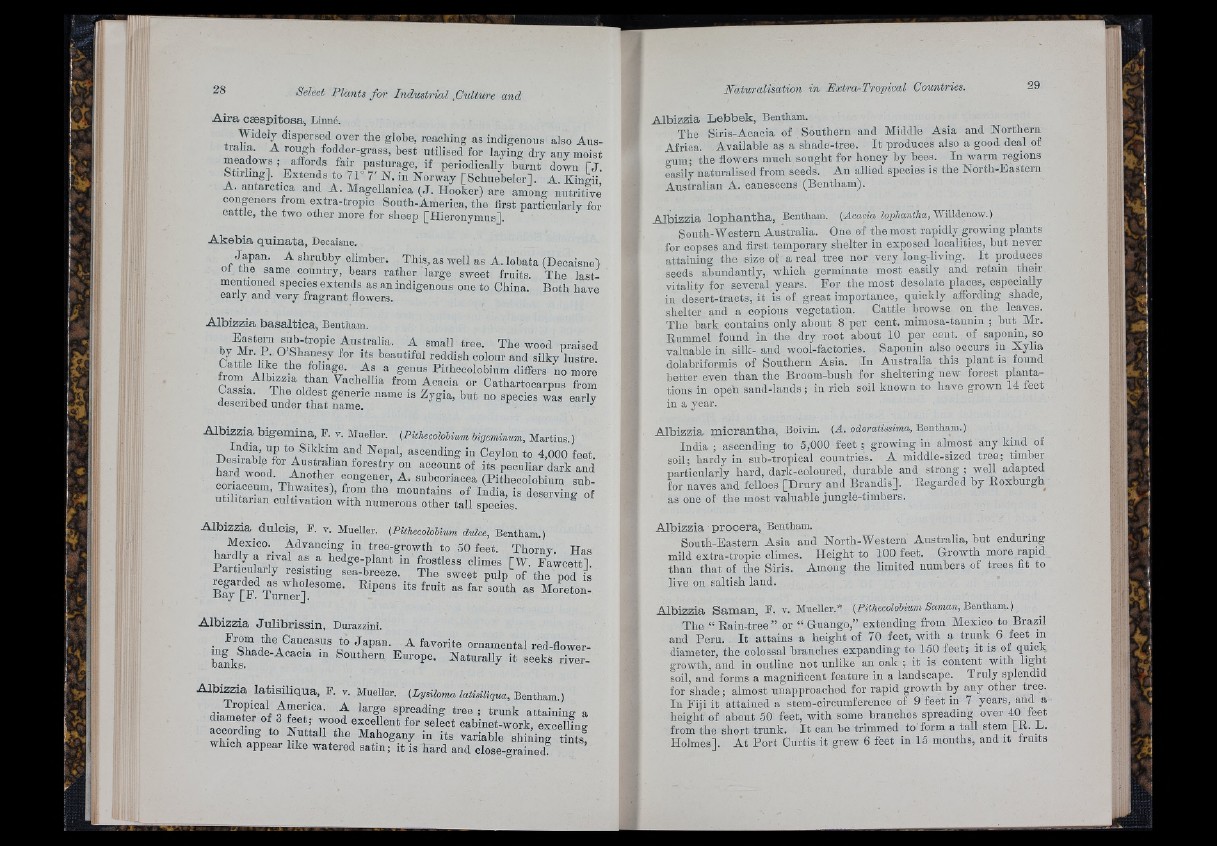
A ir a cæ sp ito s a , Linné.
Widely dispersed over the globe, reaching as indigenous also Australia.
A rough fodder-grass, best utilised for laying dry any moist
meadows; affords fair pasturage, if periodically burnt down f j .
Stirling]. Extends to 1 1° 7' N. in Norway [Schuebeler]. A. Kingii
A. .antarctica and A. Magellanica (J . Hooker) are among nutritive
congeners from extra-tropic South-America, the first particularly for
cattle, the two other more for sheep [Hieronymus].
A k e b ia q u in a ta , Decaisne.
Japan. A shrubby climber. This, as well as A. lobata (Decaisne)
oi the sa,me country, bears rather large sweet fruits. The last-
mentioned species extends as an indigenous one to China. Both have
early and very fragrant flowers.
A lb iz z ia b a s a ltic a , Bentham.
The wood praised
by Mr. P . 0 Shanesy for its beautiful reddish colour and silky lustre.
Cattle like the foliage. As a genus Pithecolobinm differs no more
frorn^ A lb ^ z ia than Vacliellia from Acacia or Cathartocarpns from
" • »"‘i
A lb iz z ia b ig em in a , F. v. Mueller. (PithecoloUum Ugeminum, Martins. )
India, up to Sikkim and Nepal, ascending in Ceylon to 4,000 feet
hard wood A of its peculiar dark and
LifncTnm Ti sobcoriaeea (Pithecolobinm subcoiiaoeum,
Thwaites), fi-om the mountains of India, is deserving of
utilitarian cultivation with numerous other tall species.
A lb iz z ia d u lc is , F. v. Mueller. (Pithecolohiiim dulce, Bentham.)
Mexico. _ Advancing in tree-growth to 50 feet. Thorny. Has
hardly a rival as a hedge-plant in frostless climes [W. Fawcett]
Particularly resisting sea-breeze. The sweet pulp of the pod fo
B f y '[P T u rle r ] Moreton-
A lb iz z ia J u lib r i s s in , Durazzini.
in the Caucasus to Japan. A favorite ornamental red-flowerhanks
“ Southern Europe. Naturally it seeks river-
A lb iz z ia la tis iliq u a , F. v. Mueller. (Lysiloma latisiUqua, Bentham.)
diameTr^nf Í spreading tree ; tru n k attaining a
diameter of 3 feet; wood excellent for select cabinet-work exoellina-
according to Nuttall the Mahogany in its variable shT n i^ tints!
which appear like watered satin; it is hard and close-grained
Albizzia L e b b e k , Bentham.
The Siris-Acacia of Southern and Middle Asia and Northern
Africa. Available as a shade-tree. I t produces also a good deal of
gum; the flowers much sought for honey by bees. In warm regions
Lsily naturalised from seeds. An allied species is the North-Eastern
Australian A. canescens (Bentham).
Albizzia lo p h a n th a , Bentham. (Acacia loplimdha, Willdenow.)
South-Western Australia. One of the most rapidly growing plants
for copses and first temporary shelter in exposed localities, but never
attaining the size of a real tree nor very long-living. I t produces
seeds abundantly, whioli germinate most easily and retain their
vitality for several years. For the most desolate places, especially
in desert-tracts, it is of great importance, quickly affording shade,
shelter and a copious vegetation. Cattle browse on the leaves.
The bark contains only about 8 per cent, mimosa-tannin ; but Mr.
Enmmel found in the dry root about 10 per cent, of saponin, so
valuable in silk- and wool-faotories. Saponin also occurs in Xylia
dolabriformis of Southern Asia. In Australia this plant is found
better even than the Broom-bush for sheltering new forest plantations
in open sand-lands ; in rich soil known to have grown 14 feet
in a year.
Albizzia m io r a n th a , Boivin. (J . odoraiissima, Bentham.)
India ; ascending to 5,000 feet ; growing in almost any kind of
soil; hardy in sub-tropical countries. A middle-sized tree; timber
particularly hard, dark-coloured, durable and strong ; well adapted
for naves and felloes [Drury and Brandis]. Regarded by Roxburgh
as one of the most valuable jungle-timbers.
Albizzia p ro o e ra , Bentham.
South-Eastern Asia and North-Western Australia, but enduring
mild extra-tropic climes. Height to 100 feet. Growth more rapid
than th a t of the Siris. Among the limited numbers of trees fit to
live on saltish land.
Albizzia S am a n , F. v. Mueller.* (PiiAecolo6i«m Samcm, Bentham.)
The “ Rain-tree” or “ Guango,” extending from Mexico to Brazil
and Peru. I t attains a height of 70 feet, with a trunk 6 feet in
diameter, the colossal branches expanding to 150 feet; it is of quick
growth, and in outline not unlike an oak ; it is content with light
soil, and forms a magnificent feature in a landscape. Truly splendid
for shade; almost unapproaohed for rapid growth by any other tree.
In Fiji it attained a stem-circumference of 9 feet in 7 years, and a
height of about 50 feet, with some branches spreading over 40 feet
from the short trunk. I t can be trimmed to form a tall stem [E . L.
Holmes]. A t P o rt Curtis it grew 6 feet in 15 months, and it fruits
'■.11